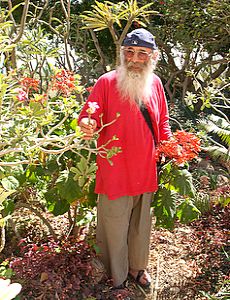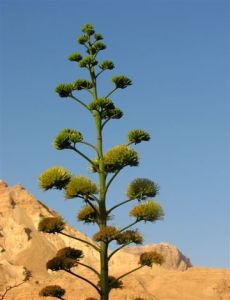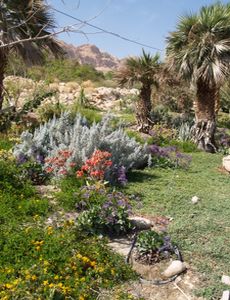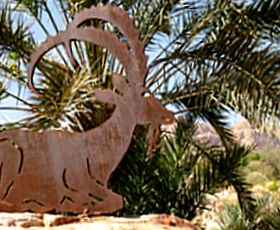
Zabu is walking with me through Kibbutz Ein-gedi’s botanical garden. Declared a botanical garden in 1994, it is unique in that its some 1,000 plant specimens from five continents are integrated around the living quarters of the kibbutz, making it the world’s only botanical garden in which people live – in this case, a population of 500.
The Judean Desert, desolate and dramatic as a moonscape, begins at but a drive of ten minutes out of Jerusalem. A half-hour later, the Dead Sea is in view, an enormous silver mirror spread across the lowest spot on earth, a sea so salty that in it no living thing can exist. In 1956, on arid land that extends to the western rim of the Dead Sea, it was here the kibbutz chose to locate.
The Song of Solomon referenced a lush oasis …
But not without precedence. “Ein-Gedi” crops up in biblical references time and time again: “My beloved is unto me as a cluster of camphire (henna) in the vineyards of Ein-Gedi” is in the Song of Solomon. Stone tools and early structures uncovered by archaeologists give evidence of thousands of years of agricultural endeavor in the area. Ein-Gedi’s four springs, emerging fresh and sweet from the earth, the result of rain in the high Judean Hills to the west gone underground, created lush oases.
“All minerals, everything here,” Zabu says of the garden. “Add water. Whoosh!”
Water, however, despite the springs, is a scarce and precious commodity. Blistering sun scorches 
A gradual emergence of a garden..
In the 1960s, Kibbutz Ein-Gedi began to introduce flora experimentally into its 25 acres of land. Plants that could not stand the harsh, desert conditions were removed. Gradually the garden emerged, dedicated to the plants indigenous to the world’s warmest climates. Represented are specimens – many endangered – from tropical areas and deserts all over the world.
Fruit trees are represented –olive, fig, pomegranate and date palms. The date palm was extensively mentioned in the Bible, but by the 14th century Ein-Gedi’s date palms were extinct. Six centuries later, the date palm was reestablished in the Judean Desert and flourishes in the botanical garden today as the most prevalent among the 40 varieties of palm trees.
Also represented are the palm-like trees of the cycadaceae family. Resistant to heat, the cycadaceae are remnants from an ancient era. Fossil cycads testify that they are as old as the dinosaurs.
Zabu pauses by a baobab from Africa so large that it would take four people holding hands to encircle its trunk. “He can become very old,” Zabu comments, “up to 2000 years.”
The jacaranda from Brazil is not doing as well. Zabu pats its trunk soothingly. “He is suffering. Not in best position.”
Increased botanical attention is being paid to cacti, with the goal of introducing more plants resistant to hot, dry conditions. We pause at a bed filled with succulents. “See,” Zabu enthuses, “how beautiful you can make with small water!”
Aromatic plants linked to ancient Ein-Gedi are well represented, with Zabu pointing out frankincense and African myrrh – “Homeland, desert Ethiopia.”
Archaeological finds spur botanical reintroductions ….

The shoots were transplanted to the oases of Ein–Gedi, where perfumers extracted the essence to create the sought-after perfume. In the 1960s, archaeologists searching the caves of Ein-Gedi came across a 2,000- year-old jug of still-fragrant oil. The plant, itself, long ago disappeared without a trace. With the help of Israeli botanists, the garden is giving high priority to its reintroduction.
Kibbutzim embracing tourism …
Kibbutzim (plural of kibbutz) are unique to Israel. The first kibbutz was established in 1909 near the Sea of Galilee; today there are approximately 270 communal settlements scattered throughout the country. Founders of the movement, most from Eastern Europe, were pioneers eager to forge a new way of life. In spite of the hostile environment, their inexperience with physical labor and lack of agricultural know-how, the scarcity of water and shortage of money, the pioneers developed thriving societies. Over the years they made barren lands bloom.
Modern-day kibbutzim has expanded from its early days of solely agricultural endeavor into various types of industry, although most retain some aspect of working the land. Many have embraced tourism, as has Kiibbutz Ein-Gedi.
In addition to operating a water-bottling plant, the kibbutz is a popular holiday destination with a 120-room resort-style hotel, restaurants, impressive conference facilities, swimming and therapeutic pools, tennis courts, and a full-service spa – all on the edge of the Dead Sea. Tourism has made Kibbutz Ein-Gedi one of Israel’s most wealthy settlements.
Of this I was not aware at the time of my visit. With “kibbutz” and “self-sustaining agriculture” firmly intertwined in my mind, I ask Zabu, as we pause to admire a display of blue agave – “homeland, Mexico” – if we might take a look at the kibbutz’ produce garden.
With a hearty laugh and a couple of words, Zabu lets me know that we would not be admiring plots of plants headed for the kibbutz’ kitchens: “We buy vegetables,” he says. “Grow money.”
“

